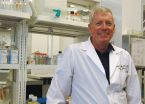(Press-News.org) How the largest animals to have ever walked the Earth fed, and how this allowed them to live alongside one another in prehistoric ecosystems is the subject of new research from the University of Bristol and the Natural History Museum, London.
The sauropods – large, long-necked plant-eating dinosaurs such as Diplodocus and Brachiosaurus – dominated the land between 210 and 65 million years ago. They were the largest land animals of all time, with the biggest weighing 80 tonnes (more than 11 elephants) and would have needed vast amounts of food.
Despite this, multiple sauropod species often lived alongside each other. The most notable example is the community of the Late Jurassic Morrison Formation, a distinctive sequence of sedimentary rock in the western United States from which over 10 species of sauropod are known.
How so many giant herbivores could have coexisted has long been a mystery: even the highly diverse faunas seen in modern Africa only support one truly gigantic species, the elephant. This is made even more puzzling by the harsh, semi-arid environment of the Morrison Formation during the Jurassic, which would have limited plant growth.
A study conducted by David Button, a PhD student in Bristol's School of Earth Sciences and the Natural History Museum, and colleagues used a novel combination of approaches to investigate this problem.
Although sauropods were gigantic, their heads were comparatively very small and so how they ingested enough food has puzzled many scientists. The researchers focussed on the skull and jaws of sauropods, using a variety of biomechanical techniques to investigate how they functioned and what this would mean for sauropod ecology.
Using CT scans, the researchers digitally reconstructed the skulls of the sauropods Camarasaurus and Diplodocus, along with the jaw and neck muscles of both species from the traces left on the bones where these muscles were attached in life. These two species are very common in the Morrison Formation, and are known to have widely co-existed. From this data, a biomechanical computer model of the skull of Camarasaurus was built using Finite Element Analysis (FEA), a modelling technique often employed in engineering and design to calculate stress and strain distribution in complex shapes. This model was then compared to a pre-existing model of Diplodocus in order to investigate how the dinosaurs fed.
David Button said: "Our results show that although neither could chew, the skulls of both dinosaurs were sophisticated cropping tools. Camarasaurus had a robust skull and strong bite, which would have allowed it to feed on tough leaves and branches. Meanwhile, the weaker bite and more delicate skull of Diplodocus would have restricted it to softer foods like ferns. However, Diplodocus could also have used its strong neck muscles to help it detach plant material through movements of the head. This indicates differences in diet between the two dinosaurs, which would have allowed them to coexist."
The researchers also used a series of biomechanical measurements from other sauropod species to calculate the functional disparity in their skulls and jaws and found that other Morrison Formation sauropods were also highly varied in feeding adaptations, suggesting different diets.
Co-author, Professor Emily Rayfield of the University of Bristol said: "In modern animal communities differences in diet such as this – termed 'dietary niche partitioning' – allow multiple similar species to coexist by reducing competition for food. Although, dietary niche partitioning has been suspected between Morrison Formation sauropods based on their structural features and patterns of tooth-wear, this is the first study to provide strong, numerical, biomechanical evidence for its presence in this fossil community."
The research also helps to shed light on the evolution of sauropod feeding mechanisms and how these gigantic creatures managed to eat enough food to sustain their tremendous bulk. Whereas earlier sauropods would have been able to eat a wide range of plants, later lineages show the parallel evolution of traits suggesting that they were more specialized in their feeding habits.
Co-author Professor Paul Barrett of the Natural History Museum added: "Our study provides insight not only into the ecology of dinosaurs but more generally into the mechanisms supporting species-richness in other animal communities, both from the fossil record and in the present-day."
INFORMATION:
The research, funded by the Natural Environment Research Council (NERC), is published today in Proceedings of the Royal Society B.
How dinosaurs divided their meals at the Jurassic dinner table
2014-10-08
ELSE PRESS RELEASES FROM THIS DATE:
The Lancet Psychiatry: Schools key to reaching the 1 in 10 children with mental health problems
2014-10-08
Schools are a vital way of reaching the 10–20% of children and young people across the globe who would benefit from some sort of mental health intervention, according to a new Series on mental health interventions in schools published in The Lancet Psychiatry.
The Series highlights that childhood is an important window for intervention because around 75% of adults who access mental health services have had a diagnosable disorder before the age of 18 [1]. What is more, estimates from high-income countries (HICs) indicate that only 25% of children with a mental health ...
Working memory hinders learning in schizophrenia
2014-10-08
PROVIDENCE, R.I. [Brown University] — A new study pinpoints working memory as a source of learning difficulties in people with schizophrenia.
Working memory is known to be affected in the millions of people – about 1 percent of the population – who have schizophrenia, but it has been unclear whether that has a specific role in making learning more difficult, said study lead author and Brown University postdoctoral researcher Anne Collins.
"We really tend to think of learning as a unitary, single process, but really it is not," said Collins, who along ...
NIST quantum probe enhances electric field measurements
2014-10-08
VIDEO:
This is an animation of NIST's new method for measuring electric field strength based on the quantum properties of atoms. The technique works for abroad range of frequencies, 1-500 gigahertz,...
Click here for more information.
Researchers at the National Institute of Standards and Technology (NIST) and the University of Michigan have demonstrated a technique based on the quantum properties of atoms that directly links measurements of electric field strength to the International ...
Researchers pump up oil accumulation in plant leaves
2014-10-07
UPTON, NY - Increasing the oil content of plant biomass could help fulfill the nation's increasing demand for renewable energy feedstocks. But many of the details of how plant leaves make and break down oils have remained a mystery. Now a series of detailed genetic studies conducted at the U.S. Department of Energy's (DOE) Brookhaven National Laboratory and published in The Plant Cell reveals previously unknown biochemical details about those metabolic pathways-including new ways to increase the accumulation of oil in leaves, an abundant source of biomass for fuel production.
Using ...
JAMA findings reveal vaccine approach to fight pandemic bird flu
2014-10-07
ST. LOUIS -- A vaccine that protects against an old strain of avian flu primes the immune system to mount a rapid response when a vaccine designed to protect against a related but different and new strain of avian flu is given a year later, according to Saint Louis University research findings reported in JAMA.
In addition, when combined with an adjuvant, which is a chemical that stimulates the immune system to produce more antibodies, a lower dose of the new avian flu vaccine worked better in triggering an immune response than a stronger dose without adjuvant. That means ...
Antimicrobial use in hospitals appears to be common
2014-10-07
A one-day prevalence survey of 183 hospitals found that approximately 50 percent of hospitalized patients included in the survey were receiving antimicrobial drugs, and that about half of these patients were receiving 2 or more antimicrobial drugs, according to a study in the October 8 JAMA, a theme issue on infectious disease. Most antimicrobial use was for infection treatment.
Despite the evidence supporting early, appropriate antimicrobial therapy, a substantial proportion of antimicrobial use in U.S. acute care hospitals may be inappropriate, based on factors such ...
Studies examine vaccination strategies for prevention, control of avian flu
2014-10-07
Two randomized trials in the October 8 issue of JAMA examine new vaccination strategies for the prevention and control of avian influenza, often referred to as "bird flu." This is a theme issue on infectious disease.
In one study, Mark J. Mulligan, M.D., of the Emory University School of Medicine, Atlanta, and colleagues compared the safety and antibody responses (immunogenicity) of different doses of influenza A/Shanghai/2/13 (H7N9) vaccine mixed with or without the MF59 adjuvant (a component that improves immunogenicity and enhances efficacy of inactivated influenza ...
E. coli outbreak at hospital associated with contaminated specialized GI endoscopes
2014-10-07
Despite no lapses in the disinfection process recommended by the manufacturer being identified, specialized gastrointestinal endoscopes called duodenoscopes had bacterial contamination associated with an outbreak of a highly resistant strain of E coli at a hospital in Illinois, according to a study in the October 8 JAMA, a theme issue on infectious disease.
The duodenoscope is different than that used for routine upper gastrointestinal endoscopy or colonoscopy. The procedure associated with these specialized scopes is endoscopic retrograde cholangiopancreatography (ERCP), ...
Tobacco use associated with increased risk of oral HPV-16 infection
2014-10-07
Study participants who reported tobacco use or had higher levels of biomarkers of tobacco exposure had a higher prevalence of the sexually transmitted infection, oral human papillomavirus type 16 (HPV-16), according to a study in the October 8 JAMA, a theme issue on infectious disease.
Oral HPV-16 is believed to be responsible for the increase in incidence of oropharyngeal squamous cell cancers in the United States. An association between self-reported number of cigarettes currently smoked per day and oral HPV prevalence has been observed, according to background information ...
Researchers find link between tobacco use and viral infection that causes oral cancers
2014-10-07
Johns Hopkins scientists have shown a strong association between tobacco use or exposure and infection with oral human papillomavirus type 16 (HPV16), the sexually transmitted virus responsible for mouth and throat cancers worldwide. The numbers of such cancers have increased 225 percent in the United States over the past two decades.
HPV16 is found in 80 percent of cancers located in the back of the throat and is transmitted through oral sex. "The practice of oral sex is common, but this cancer is rare. So there must be cofactors in the process that explain why some ...



